TO
Filters: Research Institute: "Bureau of Economic and Business Research" Collection: "ir_eua" Type: "Text" Format: "application/pdf"
| Title | Date | Subject | Description | ||
|---|---|---|---|---|---|
| 76 |
 |
Utah's Economic Patterns | 1956 | The first edition of Utah's Economic Patterns, published in December 1953, was distributed to social science teachers in Utah's high schools and colleges and to leaders in education and business. From these leaders have come a number of suggestions for this revised edition. The purpose of this ... | |
| 77 |
 |
Statistical Abstract of Utah 1973 | 1973-02 | The Bureau of Economic and Business Research presents the sixth edition of the Statistical Abstract of Utah, 1973. The basic goal of this document is to bring together under one cover the data most often requested in a readily available format. During an average year, government agencies, business f... | |
| 78 |
 |
Utah State preliminary development plan | 1969-03 | The Four Corners Economic Development Region, consisting of a 92-county area in Arizona, Colorado, New Mexico, and Utah, was established December 19, 1966, under Title V of the Public Works and Economic Development Act of 1965. On September 19, 1967 the Four Corners Regional Commission was created ... | |
| 79 |
 |
Baseline scenario 1998 | 1998-02 | ||
| 80 |
 |
Impact of defense spending on the economy of Utah | 1967 | This report is a product of studies conducted at Utah State University under a contract with the Urban Renewal Administration of the Federal Housing and Home Finance Agency, under an arrangement worked out by Robert Huefner, Utah State Planning Coordinator. It builds upon The Defense Industry of Uta... | |
| 81 |
 |
Report on the development of the Utah process: a procedure for planning coordination through forecasting and evaluating alternative state futures | 1972-09 | The Utah process development project was funded jointly by the four Corners Regional commission and the Office of Regional Economic Coordination, Department of Commerce. The request for proposal, delivered verbally by George Pantos, special Assistant to the Secretary for Regional economic coordinati... | |
| 82 |
 |
Urban planning tools for quality growth | 2000 | Formed in January of 1997, Envision Utah is a public/private community partnership dedicated to studying the effects of long-term growth in the Greater Wasatch Area of northern Utah. Sponsored by the Coalition for Utah's Future, Envision Utah and its partners - with extensive input from the public -... | |
| 83 |
 |
Transportation system map portfolio | 1969-12 | ||
| 84 |
 |
Population characteristics of the Salt Lake Metropolitan Area | 1964-01 | This study could not have been undertaken without the assistance of many. An expression of gratitude is due Dr. Osmond L. Harline, Director of the Bureau of Economic and Business Research, and Dr. Clyde N. Randall, Dean of the College of Business, of the University of Utah, who responded to the orig... | |
| 85 |
 |
State planning in Utah | 1975 | In the fall of 1967, Ken Olson was considering the approach he would take in directing Utah's state planning program. The Governor had just appointed him State Planning Coordinator, to assume responsibility for the four year old program. Ken had earlier won the respect of the Governor and the previo... | |
| 86 |
 |
The estimation of intercensal migration from birth-residence statistics: a study of data for the United State, 1950 and 1960 | 1968-02 | This is the seventh in a series* of technical and analytical reports issued by the Population Studies Center of the University of Pennsylvania. All except Report No. 6 are focussed upon some aspect of recent migration and urbanization in the United States. | |
| 87 |
 |
Utah Statistical Abstract 1983 | 1983 | The Bureau of Economic and Business Research presents the ninth edition of the Statistical Abstract of Utah, 1983. The basic goal of this document is to bring together the data most often requested in a readily available format. During an average year, hundreds of calls and personal visits are made... | |
| 88 |
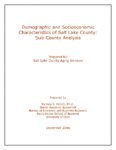 |
Demographic and socioeconomic characteristics of Salt Lake County: sub-county analysis | 2006-12 | Salt Lake County; Projections; Estimates; Aging population; Baby boom; Utah; Salt Lake Aging Services; Kennecott Land | This paper is an examination of the shifting geographic distribution of the population within Salt Lake County over time as well as an analysis of the spatial distribution of its demographic and socioeconomic characteristics. It builds on the county-level analysis included in a separate section of t... |
| 89 |
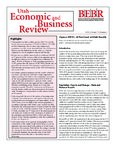 |
Census 2010 - a first look at Utah results | 2011 | Census; 2010; Utah; Demographics; Population; Age; Sex; Race; Ethnicity | Early results from the long-awaited 2010 Census are revealing the outlines of the more detailed portrait that will not be available for at least a couple more years. This essay reviews the top-level population change and geographic distribution results primarily from the redistricting data set.1 We ... |
| 90 |
 |
The coming boom in Utah's school age and college age populations: state and county scenarios | 2002-09 | Population analysts have for some time anticipated a significant increase in the school age population (5 through 17 years of age) of Utah beginning around 2004 and extending for at least a decade. At this point the question is not whether the boom will materialize, but rather, the exact timing, mag... | |
| 91 |
 |
Economic, demographic and fiscal impacts of closing Hill Air Force Base: a statewide and regional analysis | 2004-04 | The upcoming round of Defense Base Closure and Realignment (BRAC) is threatening the existence of Hill Air Force Base (Hill AFB). The Department of Defense is aggressively approaching this round of BRAC in its attempt to eliminate 20% to 25% of current capacity. The purpose of this study is to asses... | |
| 92 |
 |
Salt Lake County's distinctive demographics: implications for the aging population | 2006-12 | Salt Lake County; Projections; Estimates; Aging population; Baby boom; Utah; Salt Lake Aging Services; Kennecott Land | Salt Lake County is the economic, political, and cultural center of Utah. The county is currently home to nearly 40 percent of Utah residents and generates about half of all jobs in the state. It remains the most populous county, with a million of the state's 2.6 million residents,1 and its daytime ... |
| 93 |
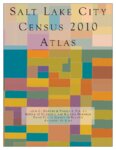 |
Salt Lake City census 2010 atlas | 2013-02 | Demographics; Salt Lake City; Utah; Census | This volume presents and analyzes results from the 2010 Census of Population and Housing. This mandatory enumeration is conducted by the federal government and is used to determine reapportionment and redistricting. This is the most complete record of population, households, and housing units that i... |
| 94 |
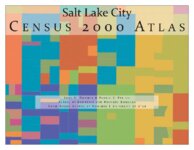 |
Salt Lake City census 2000 atlas | 2011-03 | Demographics; Salt Lake City; Utah; Census | This volume presents the basic demographic characteristics of residents of Salt Lake City as recorded in the 2000 Census of Population and Housing. Every ten years these federal governm ent counts of people are the basis of congressional apportionment and political redistricting. Data in this volume... |
| 95 |
 |
Revised Utah population estimates for the 1990s | 2001-05 | Every 10 years, the U.S. Bureau of the Census conducts a population count. In the intervening years the Utah Population Es timates Committee (UPEC) annually prepares total resident population estimates for each of the 29 counties in the state. These estimates are based on methods that ut i l i z e s... | |
| 96 |
 |
Immigrants transform Utah: entering a new era of diversity | 2004-05 | Utah is generally perceived as an extremely homogeneous state whose population can trace its ancestry mostly to northern Europe. Listings for surnames like Hansen, Jensen, and Christensen do fill many pages in local telephone directories throughout the state. According to census counts, the minority... | |
| 97 |
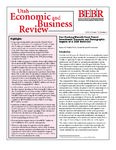 |
Fast-tracking Wasatch Front transit investments: economic and demographic impacts of a 2025 build-out | 2011 | Over the next 30 years, the Wasatch Front will significantly expand its transit network. Plans include the construction of an additional 25 miles of light rail, 76 miles of commuter rail, 227 miles of bus rapid transit, and 29 miles of mountain transportation rail line. These projects will be built ... | |
| 98 |
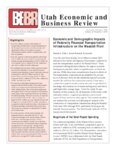 |
Economic and demographic impacts of federally financed transportation infrastructure on the Wasatch Front | 2004-09 | Over the next three decades, $14.4 billion (constant 2004 dollars) of new transit and highway infrastructure is planned to meet the transportation needs of the Wasatch Front.1 These investments will significantly influence the region's economic development potential, relative competitiveness, and la... | |
| 99 |
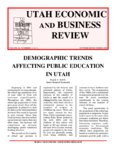 |
Demographic trends affecting public education in Utah | 2000-11 | Beginning in 2004 and continuing for at least a decade, the school age population (5 to 18 year olds) in Utah will increase significantly. Throughout the 1990s, the school age population in Utah grew more slowly than did the population in general so that its share in the total population declined. T... | |
| 100 |
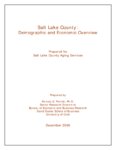 |
Salt Lake County: demographic and economic overview | 2006-12 | Salt Lake County; Utah; Demographics; Aging; Dependency ratio; Foreign born; Immigrants; Age structure; Age waves; Occupation; Labor force participation; Sex ratio; Educational attainment; commuting | Salt Lake County is the economic, political, and cultural center of Utah. The county is currently home to nearly 40 percent of Utah residents and generates about half of all jobs in the state. It remains the most populous county, with a million of the state's 2.6 million residents,1 and its daytime ... |
